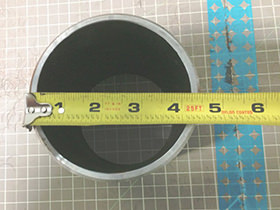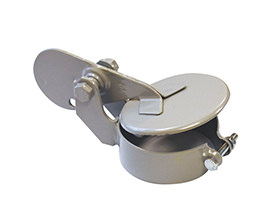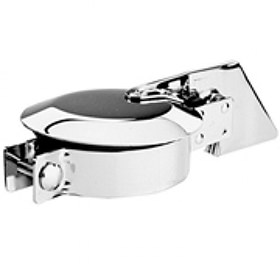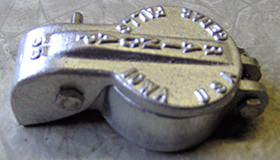Rain Cap Selection Guide
How do you determine the correct exhaust rain cap size to order?

The size of the rain cap is determined by the outside diameter of the exhaust stack. Simply apply a tape measure, ruler or caliper to the opening of the exhaust stack and measure the width of the pipe at its furthest points. Make sure to measure the outside of the exhaust pipe, not the inside. See below:

In this example, the exhaust pipe's Outside Diameter (O.D.) is 4.5 inches (a typical schedule 40 pipe size). Each K4 Innovations' exhaust rain cap listing provides the minimum and maximum pipe size the rain cap can be mounted on. Simply choose the rain cap mounting collar that falls within the range of the exhaust pipe size you measured.
Difficult to reach the exhaust stack to measure the outside diameter? No problem if you know the schedule of pipe your exhaust system uses. This information can be found in the equipment's installation and service manual or the Bill of Material from the construction system drawings. Below is a list of outside diameters (O.D.) by pipe size and schedule:
| Pipe Size (inches) | Schedule 40 O.D. | Schedule 10 O.D. | Schedule 5 O.D. |
| 0.75 | 1.05 | 1.05 | 1.05 |
| 1.00 | 1.315 | 1.315 | 1.315 |
| 1.25 | 1.66 | 1.66 | 1.66 |
| 1.50 | 1.9 | 1.9 | 1.9 |
| 2.00 | 2.375 | 2.375 | 2.375 |
| 2.50 | 2.875 | 2.875 | 2.875 |
| 3.00 | 3.5 | 3.5 | 3.5 |
| 3.50 | 4 | 4 | 4 |
| 4.00 | 4.5 | 4.5 | 4.5 |
| 6.00 | 6.625 | 6.625 | 6.625 |
| 8.00 | 8.625 | 8.625 | 8.625 |
How do you select the material or finish of the rain cap?
There are several deciding factors on the type of rain cap finish you should select.
Price: If you're looking for the most economical type of rain flapper, choose the painted rain caps. The base material is carbon steel and paint is relatively inexpensive.

Durability: Will the rain cap be exposed to a corrosive environment such as a chemical plant? Or be see operation on a continuous basis such as a primary gen set?Consider a stainless steel rain cap as its base construction of 304 or 316 stainless steel can withstand a large degree of chemicals and operating conditions.

Exhaust temperatures: Natural gas engines can have exhaust temperatures exceeding 1200 degrees Fahrenheit. In these applications, consider using a stainless steel rain cap made of 304 or 316. Aluminum rain caps can also be used on higher temperature exhaust systems of 1000 degrees Fahrenheit intermittent. Carbon steel, painted rain caps can operate at exhaust temperature up to 800 degrees Fahrenheit intermittently. The paint on these exhaust flappers are designed for higher operating temperatures. The chrome plating on the chrome rain caps can burn off at higher exhaust temperatures (i.e. above 500 degree Fahrenheit).
Aesthetics: Rain cap going onto a show tractor? Go with a high luster finish such as chrome. A stainless steel rain cap can also be eye pleasing, but doesn't have the high luster finish of a chrome rain cap.

Physical properties: Have an application that requires light weight material? Or need a rain cap that has a short counter weight dimension? Aluminum rain caps are lighter weight than their steel counterparts. And because of the lighter weight, the amount of material required for counter balance the lid is also smaller, leading to a shorter overall foot print.


